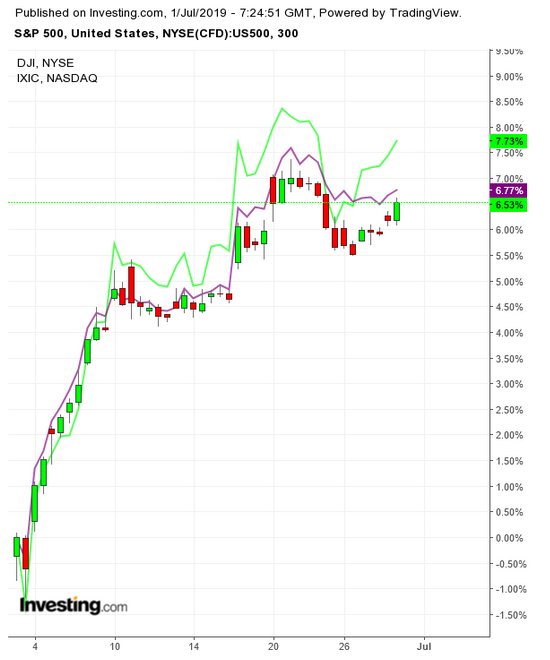Investors had to be thrilled by the stock market's performance in June. The S&P 500's gains were the best for the month since 1955. The Dow's monthly results were even better: up 7.2%, its best since 1938. As for the NASDAQ, it had its best June since 2000, up 6.9%.

Indeed, the equity market is up nicely for the year as well: the S&P 500 +17.4%, after a 3.8% second-quarter gain; the Dow was by 14.1% for the same period and the NASDAQ is higher by 20.66%. As well, futures trading suggests U.S. stocks will rally strongly on Monday, with the S&P 500 and the Dow possibly hitting new 52-week highs.
Additional Volatility, More Abrupt Moves
There's lots for investors to love. Except the abrupt and often scary pullbacks that have erupted repeatedly over the last 18 months. These have resulted in declines of 20% or so in the fourth quarter of 2018 and roughly 7% just this past May.
Between the 2016 election and the end of 2017, the U.S. major indices saw just one down month. But, since January 2018, the S&P and NASDAQ have had six down months, the Dow, five.
As a result, the S&P 500's year-to-date gain at the end of June was lower than where the benchmark stood at the end of April. It's also possible there will be more volatility ahead, though not on Monday.
Currently, financial markets are being ruled largely by forces that have fueled quick moves up or down, including:
- Trade tensions between the United States and China.
- Uneasiness in the Middle East that nearly had the United States attacking Iranian military facilities.
- Worries about North Korea and its nuclear weapons capabilities.
- Computerized trading programs that make algorithmic buy-and-sell decisions.
July will begin with the first three issues on hold, providing the catalysts for Monday's expected rally.
- The United States and China have agreed to continue trade dispute negotiations. Tariffs will be held at current levels and U.S. technology companies can sell products to Huawei, the Chinese telecommunications giant.
- The United States didn't attack Iran, in part because President Donald Trump wants to get U.S. military forces out of the Middle East.
- Worries about North Korea were diffused Sunday when Trump and Kim Jong-un met for 45 minutes at the Demilitarized Zone that separates North and South Korea. They agreed to restart talks on reducing North Korea's nuclear arsenal.
Unexpected Results; Some Deep-Seated Issues
Still, any surface calm is belied by some unexpected results that could point to more deep-seated issues:
- Most of the gains occurred during the first quarter as stocks bounced back from last fall's big slump. Second quarter gains were far more moderate.
- Utility stocks were consistent winners. The Dow Jones Utility Average gained 13.7% in the second quarter because falling interest rates made their stable and lucrative dividends attractive. During the S&P 500's 6.6% swoon in May, the Dow utilities fell just 0.7%; the index hit five new highs between May 24 and Wednesday.
- McDonald's also hit new highs. The stock (NYSE:MCD) gained 17% in the first half. The latest move higher came on Friday when it reached nearly $208, just pennies off its 52-week high.
- Apple may be up 25% on the year, but that's after the stock (NASDAQ:AAPL) fell 30% in the fourth quarter of 2018. And it's still more than 15% below its 52-week high reached last fall.
- Microsoft was the Dow leader in the first half. The software giant (NASDAQ:MSFT)—once derided as a has-been compared with Apple or Amazon (NASDAQ:AMZN)—was the second-best performer in Q2, after Disney (NYSE:DIS), whose shares took off when it announced the launch of its streaming service next fall.
- Microsoft is the only stock with a market capitalization above $1 trillion, but it may be vulnerable. Its trailing 12-month P/E ratio is nearly 30. (Amazon's trailing P/E ratio is 70, but investors have never really cared.)
Landscape Looks Favorable, But...
So what's ahead? That depends. First, on whether the events that create short, sharp swoons (tariff threats, military threats, nuclear threats) are minimized. Traders and their algorithms hate uncertainty.
The current situation is mostly favorable for stocks. Interest rates are lower. The 10-year Treasury finished the quarter at 2.0%, down 25% this year because of worries the global economy is slowing. The U.S. economy is growing at about 3% a year, to the impatience of the Trump Administration, but a recession doesn't seem likely.
The domestic unemployment rate, 3.6% in May, has fallen 64% since a 10% peak in October 2009. Initial jobless claims have fallen by two thirds since their March 2009 peak.
Big companies are continuing to buy back their stock, which spreads earnings across fewer shares, helping to support prices. Admittedly, first-quarter repurchases of $205.8 billion were down 7.7% from the fourth quarter, but they were up 8.9% from a year earlier, according to S&P Dow-Jones Indices. Apple alone has bought $23.1 billion in shares during Q1.
However, arrayed against those factors are some potential headwinds:
- U.S. manufacturing is slowing, suggesting the U.S.-China trade dispute is a big issue.
- Traditional retail is struggling against e-tail competition. Nordstrom (NYSE:JWN) is the S&P 500's biggest loser this year, down 30.5%. Macy's (NYSE:M) and Kohl's (NYSE:KSS) fell 28%.
- The agricultural economy is struggling because it depends so much on export markets. Soybean prices are up 3% this year but down a third from the end of 2012.
